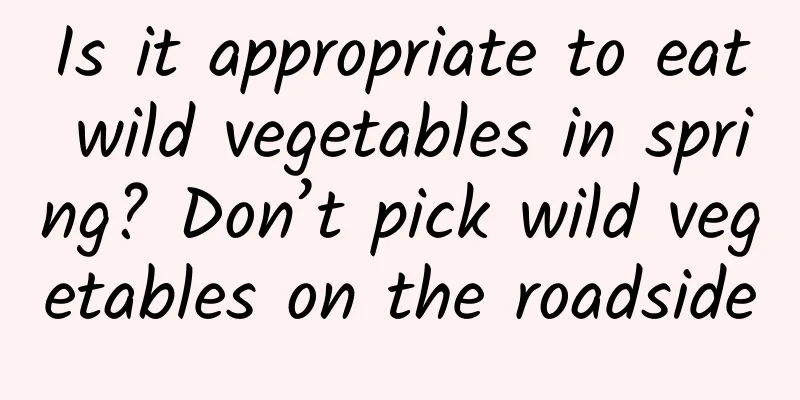Is it appropriate to eat wild vegetables in spring? Don’t pick wild vegetables on the roadside

|
With the arrival of spring, all things in nature, after sleeping for a winter, poked their heads out at the caress of the breeze, and under the careful care of the drizzle, sprouted tender new leaves and stretched their waists to their heart's content towards the sunshine. The growth of plants not only brings fresh green to the earth, but also awakens our taste buds. People follow the footsteps of spring and go to the mountains and fields to find the long-awaited delicacy, which is wild vegetables . Wild vegetables, as the name suggests, are edible plants that are not cultivated artificially. my country has a custom of eating wild vegetables since ancient times, which may be the reason why people are still happy to pick and eat wild vegetables. Zhu Su, the son of Zhu Yuanzhang in the Ming Dynasty, once wrote "Herbal Medicine for Famine Relief". The prince compiled 414 edible local plants and added exquisite woodcut illustrations in order to meet the needs of famine relief. The book not only records common wild vegetables and their edible parts, but also records some poisonous wild vegetables that need to be specially processed before they can be eaten, which is enough to show the ancients' in-depth exploration and understanding of wild vegetables. Today, there are endless books about wild vegetables, and it is becoming more and more common for people to eat wild vegetables. Of course, there are also frequent reports of poisoning from eating wild plants. Here, we advocate that everyone should not pick wild vegetables on the roadside. On the one hand, there are certain safety risks behind the wild vegetable craze. At the same time, shoveling them down with a small shovel will also damage the local ecological environment. So if you like to eat wild vegetables, you can choose to buy them in regular supermarkets, which have professional quality control and can be eaten with more peace of mind. Today we will talk about the wild vegetables that can be bought. As people living in Nanjing, we call common wild vegetables "seven heads and one head". As the "favorites" of Nanjing people, there is a saying that "Nanjing people don't know good things, they eat rice and grass at the same time". The "seven heads and one head" are toona sinensis, shepherd's purse, alfalfa, amaranth, wolfberry, pea, garlic and chrysanthemum. If you want to eat these "delicacies", you have to be very particular. Part 1 Toona sinensis head Scientific name: Toona sinensis (A. Juss.) Roem. Figure 1: Chinese toon (Image source: provided by the author) The young leaves of Chinese toon are edible. my country has a history of eating them for more than 2,000 years. The most common way to cook them is to swell eggs with Chinese toon. Northerners also like to mix Chinese toon with tofu. People who love it are fascinated by it. Every year when it is first put on the market, it costs hundreds of yuan per pound. People who don't like it stay away from it, perhaps because they can't enjoy its strong taste, just like many people don't eat coriander. Figure 2: Chinese toon (Image source: provided by the author) Although Chinese toon is delicious, there is another kind of toon, Ailanthus altissima (Mill.) Swingle, which also has pinnate leaves and looks very similar to Chinese toon, but it is not edible. Figure 3: Ailanthus altissima (Image source: provided by the author) Part 2 Shepherd's Purse Scientific name: Capsella bursa-pastoris (L.) Medic. Figure 4: Shepherd's purse (Image source: provided by the author) The deliciousness of shepherd's purse has long been known to the ancients. The Book of Songs praised it as "Who says tea is bitter? It is as sweet as shepherd's purse". Du Fu also wrote in "Di Mingfu (Boji, also known as "To Di Mingfu")" "Who says tea is bitter and as sweet as shepherd's purse"? Su Dongpo was very fond of shepherd's purse. He made a soup with shepherd's purse, which became a delicacy called "Dongpo Soup". In the Ming Dynasty, Li Shizhen wrote in Compendium of Materia Medica: "Shepherd's purse grows in abundance, so it is called shepherd's purse". The "abundant" here means numerous, which shows how widespread and numerous shepherd's purse is. There is a folk proverb that "On March 3, shepherd's purse flowers bloom on the stove mountain". In Nanjing, the custom of "On March 3, shepherd's purse flowers boil eggs" is also preserved. Figure 5: Boiled eggs with shepherd’s purse (Image source: provided by the author) Of course, the most common way to eat shepherd's purse is to chop the tender leaves and make shepherd's purse dumplings and buns. However, the young heads of shepherd's purse are quite difficult to identify and can easily be confused with the seedlings of other plants, so don't pick them in the wild! Part 3 Clover Head Scientific name: Medicago polymorpha L. Alfalfa is also called "grass head", which shows that it comes from wild grass. Alfalfa is also called "grass", and is known as the "king of forage grass". When Zhang Qian went to the Western Regions, he brought many excellent crops to China, and alfalfa was one of them. Mei Yaochen, a poet in the Song Dynasty, wrote in "Ode to Alfalfa": "When alfalfa came to the Western Regions, grapes followed. The Hu people did not cherish it at first, but the Han envoys were able to keep it. The Wan horses should seek the sun when they left the palace and planted it in the old time. The yellow flowers are now blooming spontaneously, stirring up the cattle grazing ponds." It can be seen that the Han people had long used alfalfa as forage. Of course, when famine came, people would also pick the young leaves of alfalfa as food. The Shaanxi proverb "Guanzhong women have three loves: cotton, stir-fried balls and alfalfa" is a true portrayal of people's consumption of alfalfa heads. Figure 6: Alfalfa (Image source: provided by the author) Figure 7: Oxalis (Image source: provided by the author) Figure 8: White Clover (Image source: provided by the author) The alfalfa garden at the foot of Purple Mountain in Nanjing is where the imperial court planted alfalfa to feed horses in ancient times. The alfalfa eaten by the locals is the tender tips of southern alfalfa, but it also grows with Oxalis corniculata L. and Trifolium repens L. At a glance, their tender leaves are all three, but southern alfalfa has pinnate trifoliate leaves, while Oxalis corniculata and Trifolium repens have palmate trifoliate leaves. How many people can guarantee that they will not pick the wrong ones when they grow together? So it is better not to pick them in the wild. Figure 9: Malan (Image source: provided by the author) Part 4 Amaranthus Scientific name: Aster indicus L. Li Shizhen recorded in Compendium of Materia Medica: "Its leaves are like orchids but larger, and its flowers are like chrysanthemums but purple. It is commonly known as the largest thing, which is the horse, hence the name." Therefore, Malan is also called purple chrysanthemum. The method of using Malan head is very simple. After picking the tender tips, wash and chop them, and mix them with dried tofu for a cold dish. It is very delicious. Figure 10: Malan (Image source: provided by the author) Figure 11: Iris (Image source: provided by the author) Speaking of Malan, will everyone sing involuntarily: "Little ball, banana pear, Malan blooms twenty-one. Twenty-five-six, twenty-five-seven, twenty-eight, twenty-nine, thirty-one...", although what I heard when I was a child was "One, two, three, four, five, six, seven, Malan blooms twenty-one. Twenty-five-six, twenty-five-seven, twenty-eight, twenty-nine, thirty-one...", the Malan mentioned here refers to Iris lactea Pall., a plant of the genus Iris, also commonly known as Malan or Malan flower. Part.5 Wolfberry head Scientific Name: Lycium chinense Miller Figure 12: Wolfberry (Image source: provided by the author) Figure 13: Wolfberry (Image source: provided by the author) The tender tips of wolfberry can be eaten as vegetables in spring. The Book of Songs records that "I climbed the northern mountains to pick wolfberries". Wolfberry is a treasure. The Compendium of Materia Medica records that "in spring, the leaves of wolfberry are called Tianjingcao; in summer, the flowers are called Changshengcao; in autumn, the seeds are called wolfberry; in winter, the roots are called Digupi". People have fully explored the value of wolfberry, and soaking wolfberry in a thermos cup is enough to prove people's recognition of its efficacy. But then again, if you want to eat it, on the one hand, remember to buy it in a regular place, and on the other hand, just try it and don't eat too much. Part 6 Pea Head Scientific name: Pea Pisum sativum L. Figure 14: Peas (Image source: provided by the author) "Compendium of Materia Medica" records that "Shanrong is pea, its seedlings are soft and tender, so it is named pea, and it is planted in Hurong, which is now very common in northern China." Pea heads are the tender tips of peas, when the peas have not yet bloomed, and they have a fragrant taste after being stir-fried. The ancients also liked to eat pea heads, but they called them "wei". "The Book of Songs·Xiaoya·Picking Wei" records that "Picking Wei, picking Wei, Wei is also stopped... Picking Wei, picking Wei, Wei is also soft... Picking Wei, picking Wei, Wei is also hard." The ancients picked pea heads. Figure 15: Pea cake (Image source: provided by the author) In addition to eating pea tips, the ancients also made pea seeds into a variety of delicacies. The most famous one may be pea cake, which was called pea yellow when it was introduced to the capital. It is mainly made of peas, red dates, persimmons and gardenias. "A Grand View of Chinese Imperial Cuisine" records that "food has always belonged to Yanjing, pea yellow has long been famous, red dates are inlaid with gold currants, and yellow dates can be bought for ten cents a piece." Figure 16: Saving Wild Peas (Image source: provided by the author) Figure 17: Widespread Vicia (Image source: provided by the author) There is also a saying that the tender tips of Vicia plants are picked and eaten, such as the tender tips of Vicia sativa L. From its name "rescue", we can know that it was once eaten in emergencies. Other common Vicia plants include Vicia cracca L., Vicia hirsuta (L.) SF Gray and Vicia tetrasperma (L.) Schreber. Figure 18: Small vetch (Image source: provided by the author) Figure 19: Four-seeded wild pea (Image source: provided by the author) But! Here’s the important point! These wild peas all contain a toxic compound called viburnum, and this toxin will continue to increase as they bloom and bear fruit. Therefore, it is necessary to blanch the pea tips in water when we cook them, so that the pod glycosides inside can be effectively removed. At this point, I want to say that you should not eat wild pea tips. If you are really greedy, you can go to the supermarket or vegetable market to buy artificially grown pea tips. In comparison, this kind of pea tips basically does not contain toxins. Part 7 Small garlic Scientific name: Allium macrostemon Bunge Figure 20: Garlic Roots (Image source: provided by the author) Xiebai, also known as garlic root, is recorded in the Book of Rites: Nei Ze: "For minced meat, spring uses onion, autumn uses mustard; fat uses onion, and paste uses leek." It can be seen that my country has already started to eat Xiebai before BC, and it is a very easy-to-obtain medicinal and edible product. The Compendium of Materia Medica praises it as: "Nothing is more beautiful than Zhi, so Xie is a vegetable Zhi." Wang Zhen of the Yuan Dynasty also said: "Xie, when raw, is pungent, and when ripe, it is sweet. It is not rotten when planted, and it is beneficial to eat." Bai Juyi also wrote the poem "Looking at millet as winter wine, leaving Xie as spring vegetable." Xiebai and scallion are both plants of the genus Allium in the Amaryllis family, and they have similar tastes. Therefore, when cooking Xiebai, you only need to refer to chives or scallions. For example, Xiebai scrambled eggs and Xiebai pancakes are all very easy to make. As for what you need to pay attention to when eating, just be careful to stop when enjoying the delicious food, after all, it has a strong taste. Part 8 Chrysanthemum brain Chrysanthemum indicum 'Nankingense' If we were to ask which wild vegetable is the most characteristic of Nanjing, it would be chrysanthemum brain. The fact that it is listed separately among the seven heads and one brain shows its specialness. When it comes to brain, the first thing that comes to mind may be pig brain, sheep brain, rabbit brain, etc. How come chrysanthemum also has a brain? And people like to eat it? Figure 21: Chrysanthemum brain (Image source: provided by the author) Don't panic, let me tell you slowly. Figure 22: Chrysanthemum brain (Image source: provided by the author) In fact, chrysanthemum brain is a cultivated species of wild chrysanthemum, a plant with both medicinal and edible properties, and rich in nutritional value. Chrysanthemum brain can also be said to be the head of chrysanthemum, after all, the tender tips of wild chrysanthemum are picked. Chrysanthemum brain is what Nanjing people call it, and it is closer to chrysanthemum láo when spoken in Nanjing dialect. In front of and behind the houses of local residents in Nanjing, chrysanthemum brain can often be seen. Chrysanthemum brain egg soup is definitely beyond tomato egg soup. It is refreshing and cool, which is enough to prove people's love for it. Figure 23: February orchid (Image source: provided by the author) Figure 24: Fried bacon with orchid (Image source: provided by the author) Part 9 The wild vegetable family is more than just “seven heads and one brain”! In addition to the "seven heads and one brain", there are many edible wild vegetables in my country. In the second month of the lunar calendar every year, the blue-purple February orchid blooms all over the ground, attracting countless tourists to check in and take photos. February orchid is also called Zhugecai Orychophragmus violaceus (Linnaeus) OE Schulz. According to legend, when Zhuge Liang led his troops to war, due to food shortages, he sent soldiers to dig up Zhugecai and other food. The "Illustrated Guide to Chinese Higher Plants" records: "The stems and leaves of Zhugecai can be eaten as wild vegetables." Before the February orchid blooms, its tender tips are edible. Those February orchids that grow lush and in the sun have a less bitter taste and can be stir-fried after blanching. Figure 25: Elm (Image source: provided by the author) When the orchids bloom in February, the elm tree Ulmus pumila L. is also full of fruits. Because its winged fruits are oblate and resemble ancient copper coins, they are named "elm coins", which is a homonym of "surplus money". Northerners like to mix fresh elm coins with corn flour, steam them, and then mix them with sauce to eat. They are so delicious. Before the Qingming Festival, people would also beat the fresh stems and leaves of Pseudognaphalium affine (D. Don) Anderberg and Artemisia argyi Lévl. et Van. into pulp, mix it with glutinous rice flour, and add various fillings to make Qingtuan. Yuan Mei, a Qing Dynasty gourmet, recorded the production of Qingtuan in Suiyuan Food List: "Pound the green grass into juice, mix it with flour to make a ball, the color is like jasper." Figure 26: Artemisia serrata (Image source: provided by the author) Figure 27: Ai (Image source: provided by the author) After being steamed, the green rice dumpling is green and oily, glutinous, soft, fragrant and refreshing. It has been loved by people since ancient times. However, it was mostly used for sacrifices in ancient times. Now, after thousands of years, it has become one of the seasonal specialty snacks. In addition to Qingtuan, Wufan rice is also one of the special snacks. It is a folk snack in the south of the Yangtze River. People pick fresh leaves of the Wufan tree (Vaccinium bracteatum Thunb.) in spring, pound them into juice and mix them with glutinous rice. The Compendium of Materia Medica records: "Pick the leaves of the Vaccinium bracteatum Thunb., pound them, soak them in water to extract the juice, and steam and cook polished rice or glutinous rice to make black rice. Long-term consumption can make you light and bright, keep your hair black, and increase your energy and strength and prolong your life." Figure 28: Blueberry Tree (Image source: provided by the author) When April comes, the Robinia pseudoacacia L. flowers bloom, and the fragrance floats in the air, attracting bees to feed on the nectar and obtain locust flower honey. It also attracts greedy people to pick them. They can't wait to pick a handful and taste the long-awaited sweetness, and then harvest the locust flowers one by one. After blanching them at home, they can make a variety of delicious foods. Skillful housewives can simply cook locust flower scrambled eggs and make locust flower dumplings. The natural floral fragrance fills the taste buds in the mouth, leaving an endless aftertaste. Figure 29: Robinia pseudoacacia (Image source: provided by the author) Of course, people are not satisfied with enjoying this delicacy only in spring. They also dry the locust flowers and store them, and then make locust flower buns in autumn and winter. Another similar wild vegetable is Purslane Portulaca oleracea L. Its tender stems and leaves can be eaten directly as vegetables in spring. Compendium of Materia Medica records: "Many people pick the seedlings, cook and dry them as vegetables." After drying, Purslane can be pickled into pickles, or made into buns similar to pickled mustard greens. However, Purslane has a light sour taste, which is not liked by everyone. Figure 30: Purslane (Image source: provided by the author) At this time, the flowers of Broussonetia papyrifera (L.) L'Hér. ex Vent. are in bloom. People will pick the male flowers of the Broussonetia papyrifera to make delicious food. They pick the male flowers that have not yet fully opened, wash them, mix them with flour and steam them. Although they don't look very good, they still taste good. Figure 31: Paper mulberry (Image source: provided by the author) Figure 32: Steaming paper mulberry flowers (Image source: provided by the author) In spring, there are so many edible wild vegetables in my country. Northerners like to eat Silene conoidea L., Bassia scoparia (L.) AJScott, Taraxacum mongolicum Hand.-Mazz. and Chenopodium album L., while Southerners also eat water celery Oenanthe javanica (Bl.) DC., Bombax ceiba Linnaeus, Artemisia selengensis Turcz. ex Bess. and Houttuynia cordata Thunb. Figure 33: Konjac (Image source: provided by the author) Figure 34: East Asian konjac (Image source: provided by the author) Figure 35: Amorphophallus truncatus (Image source: provided by the author) There are also some special wild vegetables that contain toxins and should be eaten with caution. For example, the konjac tofu we like to eat is made from the tubers of the konjac Amorphophallus konjac K. Koch. The whole konjac plant is poisonous, and the tubers contain the most toxins. If you want to taste the deliciousness of konjac, professionals must perform a series of special treatments. First, grind the konjac tubers into pulp, then add a certain amount of alkaline water and stir it thoroughly. Only after cooking or steaming can the toxins in the konjac be removed. It should be noted that not all konjac can be used to make konjac tofu, so if you want to eat it, be sure to purchase it through formal channels. In addition, wild plants such as ferns Pteridium aquilinum var. latiusculum (Desv.)Underw.ex Heller, wild mushrooms, etc. also need to undergo special treatment to remove toxins, so if you see these little guys in the wild, it is better not to disturb them, let alone try to eat them. In short, it is not recommended that you collect them in the wild, because my country is one of the countries with the richest plants in the world, and most of us do not have solid knowledge of botanical classification, and the probability of making mistakes when picking is very high. What's more, after thousands of years of inheritance, the ancients did not develop these wild vegetables into vegetables for cultivation. This shows that after trying, our ancestors found that these wild vegetables all have more or less some problems that make them unsuitable as vegetables. For example, eating too much of many wild vegetables will cause gastrointestinal discomfort, and the environment in which some wild vegetables are located may be polluted or sprayed with pesticides. Why should we pick these wild vegetables and eat them as vegetables? Of course, if we really like it, we can go to supermarkets or vegetable markets to buy it. In order to meet public demand, botanists have developed a variety of varieties and technologies for artificial large-scale cultivation of wild vegetables. In this way, we can satisfy our taste buds and ensure our health. Why not do it? Produced by: Science Popularization China Author: Qin Yalong (Institute of Botany, Chinese Academy of Sciences, Jiangsu Province, Nanjing Zhongshan Botanical Garden) Producer: China Science Expo |
<<: The seemingly simplest complex question: What exactly is life?
>>: We have many misunderstandings about addiction
Recommend
Don’t ever say you don’t know these 13 wild cat species in China!
Cats are one of the most charming animals in natu...
The most comprehensive guide to short video distribution on Tik Tok, Kuaishou, etc.!
In the Internet age, short videos are king. 2018 ...
[Popular Science] Why are many quadruped robots designed to look like dogs?
If you’re at all interested in robots—and frankly...
Extremely sharp! Every year people are injured by it
The grass is green and the birds are singing, the...
Tencent's internal test is exposed, is the hand-swipe payment coming? Industry experts: The application prospects are not optimistic
"If you can pay by swiping your palm, you wi...
Why is it so difficult to start a business? Here are a few key points where you may fail
[[146094]] After several entrepreneurial teams su...
5 signs that you may have sarcopenia! Be sure to do these two things!
Whether you are at work or at home recently In fa...
WeChat group novel project monthly income 10,000-30,000 practical operation method 2.0
Tutorial Contents: Section 1: Advantages of WeCha...
If your arm is blue after having your blood drawn as if you were beaten, it’s probably because you pressed the wrong button!
I believe you must have had such an experience of...
Can it make "Halo" shake? "DESTINY" PS4 version game experience
Since Bungie was acquired by Microsoft in 2000, &...
From mid-to-late stage lung cancer to successful anti-cancer treatment, this doctor has been actively fighting cancer for 9 years and summed up these 6 points
Many people are afraid of cancer and think that i...
2021 Short Video Basic Training Camp, learn how to play in 7 seconds and quickly learn how to monetize
2021 Short Video Basic Training Camp, learn how t...
Rolls-Royce's first SUV official spy photos revealed
Recently, Rolls-Royce released two official spy p...
Marketing strategies for domestic brands
In the "Laotan Pickled Cabbage" inciden...
Geely's first 7-seat mid-size SUV spy photos
According to the latest news from spies, road tes...









